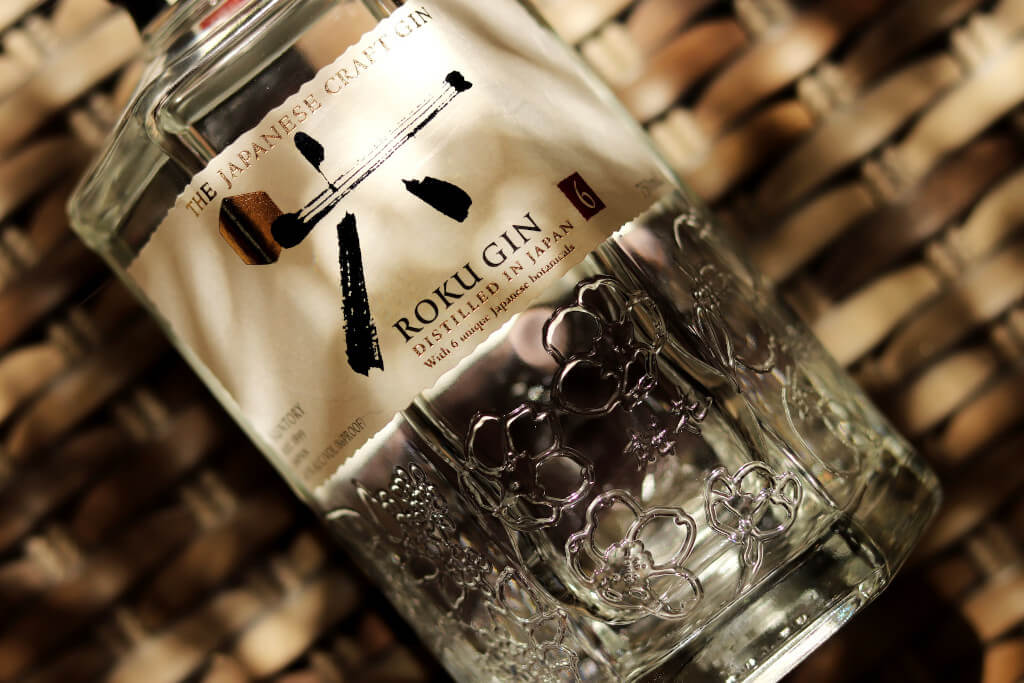In the pulsating heart of the Japanese spirits industry, a new star has risen over recent years — Roku Gin. Suntory, a titan in the beverage sector with nearly two centuries of history, introduced Roku Gin to the world. You need to know its origins to understand how Roku, which translates to “six” in Japanese, arrived at this juncture. Also, it will help you enjoy everything it has to offer.
Historically, gin has held a modest presence in Japan compared to the giants like sake, shochu, and beer which have been staple beverages for the locals. However, about half a decade ago, a gin renaissance began, with new distilleries popping up across the country. At the forefront of this resurgence was Roku Gin, a spirit that not only impressed the Japanese market but also made substantial inroads globally, including in the United States.
A critical element to Roku Gin’s success stems from Suntory’s established network of global distribution. This, coupled with the careful incorporation of unique Japanese botanicals that echo the country’s nature, has crafted a gin that resonates well with a broad spectrum of gin enthusiasts.
What Are The Basic Specs of Roku Gin?
If you’re considering purchasing a bottle of this remarkable gin, it’s essential to know the specifics regarding its availability and pricing. Since its inception in 2017, Roku Gin has been marketed in a single yet distinctive variant.
You’ll find this gin housed in a hexagonal bottle, mirroring the number of Japanese botanicals used in its formulation, available in a standard size of 750 ml. Despite its artisanal status and the labor-intensive production process it undergoes, it maintains an accessible price point, starting at $31.99.
Noteworthy is its potent strength, standing at 86 Proof, a degree higher than many regular spirits, giving you a gin that offers a stronger punch in every sip.
How to Drink Roku Gin

You’ve got your Roku Gin, and now the question arises: how to best enjoy it? This gin is a versatile player in the liquor cabinet. It can shine in a sophisticated martini or can simply be enjoyed neat to appreciate its rich botanical profile.
When you decide to concoct a classic gin and tonic, prepare for a drink with a Roku Gin twist. The unique botanicals come forward, offering a burst of unexpected yet pleasant flavors.
Roku Gin opens up a myriad of delightful options for enjoying this sophisticated spirit. To appreciate the depth and complexity of its flavor profile to the fullest, it might be an excellent idea to try it the Japanese way. In Japan, the approach to drinking gin involves a great deal of reverence for balance, harmony, and the seasonality of ingredients, inspired by the country’s rich cultural heritage. This is how the locals do it in Japan:
Step 1: Choosing the Right Glass
Select the appropriate glass for your drink. The Japanese often prefer a glass that complements the drink’s character. For Roku Gin, a wide-brimmed glass would be a great choice to allow the delicate botanicals to breathe and for you to fully appreciate the gin’s aromatic complexity.
Step 2: Setting the Temperature
While Roku Gin can be enjoyed neat or over ice, you can also try it slightly chilled to accentuate its refreshing characteristics. To do this, place your glass in the freezer for about 15 to 20 minutes before you intend to use it. The slight drop in temperature can sharpen the gin’s finer notes, giving you a more refreshing experience.
Step 3: Pouring the Gin
Pour your glad with a little bit of oomph and passion. This isn’t just about filling your glass; it’s about creating a harmonious balance between the gin and any other elements you choose to add to your drink. Go ahead and pour a substantial amount, typically 50ml, to allow the gin’s nuanced flavors to take center stage.
Step 4: Selecting the Garnish
In Japan, gin is often enjoyed with a subtle garnish that enhances the drink’s flavors without overshadowing them. Considering the Roku Gin’s botanical profile, you might opt for a garnish of sliced ginger or a twist of yuzu peel to echo its Japanese roots and maintain a harmonious flavor profile.
Step 5: Adding the Mixer
If you’re mixing a gin and tonic, now is the time to add your chosen tonic water. The Japanese prioritize quality in every aspect of a drink, from the primary spirit to the mixer. Choose a tonic that matches the quality of Roku Gin, pouring it gently down a bar spoon to retain the effervescence.
Step 6: Stirring it Right
Use a bar spoon to blend the elements smoothly without agitating the liquid too much. A gentle stir is all that is needed to harmoniously unify the ingredients, preserving the effervescence and the complex notes of your gin.
Are you Not Into The Sound Of Roku? Test These Alternatives
Roku Gin stands tall with a personality deeply rooted in Japanese culture, but there are other notable gins that you might want to consider. If you find pleasure in exploring botanical flavors, “The Botanist Islay Dry Gin” could be up your alley. Sourced from Scottish botanicals, it might cost you around $10 more per bottle compared to Roku Gin.
Perhaps, you are more inclined towards American gins; in that case, “Aviation Gin” would be a suitable, less costly alternative. Owned partly by Ryan Reynolds, this gin promises quality akin to that of Roku Gin.
For those keen on sticking with Japanese gins, “Ki No Bi Kyoto Style Dry Gin” and “Nikka Coffey Gin” offer distinct flavors at higher price points, giving you options that stretch from mid-range to premium selections.
Two Burning Questions About Roku Gin
Before you proceed to secure a bottle for yourself, let’s address two of the most commonly asked questions to give you a fuller understanding of what you are investing in.
- Is Roku Gin gluten-free?Yes, you can rest easy knowing that Roku Gin is gluten-free, which is achieved through the utilization of molasses in the base alcohol.
- Can vegans enjoy Roku Gin?Absolutely. The production process of Roku Gin does not involve any animal products, allowing it to be a choice for vegans.
What Don’t You Know About Roku Gin?

Botanical Profile: The gin involves a blend of 14 botanicals, out of which six are specific to Japan, shaping its distinct character.
Distillation Process: Roku Gin undertakes a meticulous distillation process involving different pot stills to bring out the full flavors of the Japanese botanicals.
Packaging Details: The hexagonal bottle not only stands as a reference to the six Japanese botanicals but also brings a minimalist yet elegant aesthetic to your liquor cabinet.
Alcohol Content: With an alcohol content of 43%, it assures a robust flavor profile, standing stronger compared to most regular spirits.
Now you may be left wondering what particularly are those 14 botanical blends we mentioned. Well we have them listed right here for you because how can we expect you to pair or mix anything with Roku if you don’t have a detailed flavor breakdown:
Juniper Berries: The quintessential gin ingredient, they impart a vibrant yet piney note that is a classic signature in gin.
Angelica Root and Seeds: Utilized for its earthy and somewhat herbal nuances that anchor the gin’s floral and citrus tones.
Coriander Seeds: Adds a slightly spicy and citrus hint, complementing the complex profile of the gin.
Cardamom Pods: These pods bring a spicy, eucalyptus-like scent, offering a warming sensation to the gin’s blend.
Citrus Peels: Generally sourced from lemon and/or lime, they introduce a vibrant and refreshing citrus note.
Cinnamon Sticks: Integrated for a delicate spicy touch that intertwines seamlessly with the gin’s other ingredients, giving a warm undertone to the blend.
Citrus Fruits: Apart from the peels, whole citrus fruits might be used to augment the refreshing citrus notes in the blend.
Bitter Almond: Sometimes used in gin production, bitter almond can add a nuanced bitter and nutty profile, although it wasn’t explicitly mentioned in your article, it’s a common component in gins.
Alongside these classic ingredients are six Japanese botanicals, these botanicals include:
Sakura Flower: Introducing a floral note that is subtly sweet, giving the gin a gentle blossom-like aroma.
Sakura Leaf: It enhances the floral notes with a more grounded leafy undertone, balancing the sweetness of the sakura flowers.
Yuzu Peel: A citrus element that is uniquely Japanese, providing a tart, yet fragrant citrus note that is deeper and more complex than the common lemon or lime.
Green Tea (Sencha & Gyokuro): These tea varieties introduce a fresh, grassy note, offering a gentle bitterness that aligns well with the gin’s citrus components.
Sansho Pepper: A Japanese pepper variety, it imparts a mildly spicy yet aromatic note, adding a layer of complexity to the gin’s profile.
Ginger: Often used in Japanese cuisine for its aromatic and spicy kick, it contributes a warming and spicy depth to the gin, although not mentioned in your article it pairs well with the existing botanicals in Roku Gin.
That’s all folks! Through this guide, we hope you now have a rounded understanding of Roku Gin, from its historical background to its presentation in the market today. Are you ready to treat yourself to a Roku Gin experience? What Japanese botanical in Roku’s lineup intrigues you the most? Share your Roku cocktail creations and preferences with us; we’re eager to hear your take on this crafted gin’s versatility and unique profile.

